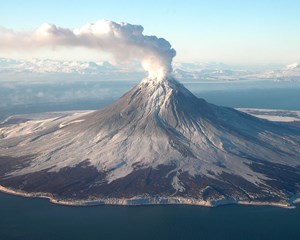As he writes in Open Science, he suspects these are found beneath every active and dormant volcano, though the concentration of copper in the brine concerned will vary from place to place. His evidence comes from electromagnetic surveys carried out on some 40 volcanoes, including Mount Fuji in Japan, Mount St Helens in America and others in Bolivia, New Zealand, the Philippines and elsewhere. These surveys consistently pick up highly conductive zones 2km or more beneath the surface, for which the simplest explanation is the presence of super-salty metalrich brines. This conjecture is reinforced by analysis of rock samples recovered from such depths under a number of volcanoes. These do indeed contain brines with varying concentrations of copper, as well as other valuable metals including lithium, ZINC, gold and silver.
正如他在《開放科學》中所寫的那樣,他懷疑在每座活火山和休眠火山下都能找到銅,只不過有關鹵水中的銅濃度因地而異。他的證據來自于對約40座火山進行的電磁調查,其中包括日本的富士山、美國的圣海倫斯火山以及玻利維亞、新西蘭、菲律賓等地的其他火山。這些探測始終能探測到地表以下2公里以上的高導電性區域,對此最簡單的解釋是存在超咸的富金屬鹵水。這一推測通過分析從許多火山下這樣深度的巖石樣本得到了證實,里面確實含有不同濃度的銅以及其他有價值的金屬,包括鋰、鋅、金和銀。
All this suggests that copper could be drilled for commercially in the same way that oil is—except that the boreholes involved would be considerably deeper. That would be difficult, but not out of the question. It would require equipment that could withstand temperatures greater than 400°C and contact with brines ten times saltier than seawater. But the prize would be worth it.
所有這些都表明銅可以像石油一樣用于商業開采——除了鉆孔要深得多之外。這很困難,但也不是不可能。它需要設備能夠承受超過400°C的溫度,并與比海水咸10倍的鹵水接觸。但這是值得的。它需要設備能夠承受超過400°C的溫度,并與比海水咸10倍的鹵水接觸。但這是值得的。

Individual volcanoes would, admittedly, yield only a fraction of the output of a big copper mine. Dr Blundy and his colleagues estimate, for example, that there might be as much as 1.4m tonnes of copper beneath New Zealand's White Island volcano, whereas the world's largest mines hold tens of millions of tonnes of it. But there are only a handful of such mines, most in mountain ranges near the Pacific coast of the Americas. By contrast, hundreds of volcanoes exist around the world, ready be tapped.
不可否認的是,單個火山的產量只是大型銅礦產量的一小部分。例如,布倫迪博士和他的同事們估計,在新西蘭的懷特島火山下可能蘊藏著多達140萬噸的銅,而世界上最大的銅礦則蘊藏著數千萬噸的銅。但是像這樣的礦山只是少數,大多數都在美洲太平洋海岸附近的山脈當中。相比之下,世界上有數百座火山正等著開發。
The temperature at which the equipment used would have to operate, moreover, brings an opportunity. The heat involved might be employed to generate electricity—enough to power the drilling operation and perhaps even to yield a surplus. Sucking copper out of Earth's crust through 2km-long straws might thus be that rare thing in the mining industry, an actual environmental good.
此外,所使用的設備必須運行的溫度也帶來了機會。其中產生的熱量可以用來發電——足夠為鉆井作業提供動力,甚至可能產生盈余。因此,用2公里長的吸管從地殼中吸銅可能是采礦業罕見的事情,但卻是真正的環保產品。
譯文由可可原創,僅供學習交流使用,未經許可請勿轉載。











